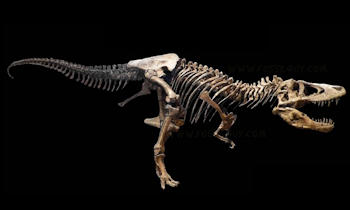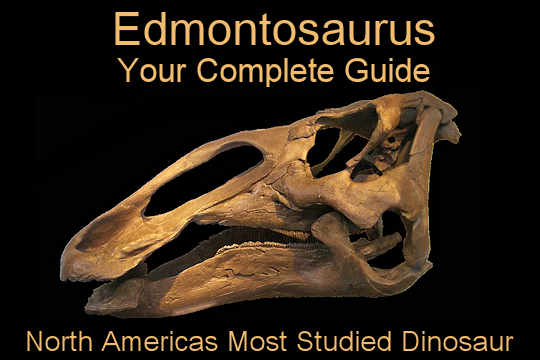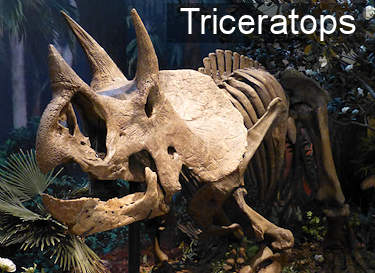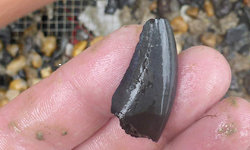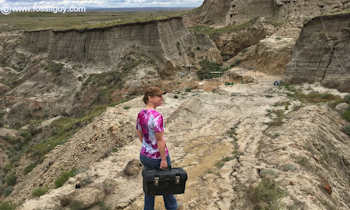Paleontology News

Artist's rendering of a juvenile dromaeosaurid 70 million years ago on the Prince Creek Formation in northern Alaska. Rendering by Andrey Atuchin
A Baby Dromaeosaur (Raptor) fossil found in northern Alaska indicates these dinosaurs lived in the polar regions year round
Summary Points

Figure 3 from Chiarenza et al. 2020 showing the anterior portion of a dromaeosaurid dentary that was found in northern Alaska.
Dromaeosaurs, commonly known as raptors, are small to medium sized feathered theropod dinosaurs.
Researchers from Southern Methodist University found a lower jaw bone of a juvenile dromaeosaur in the Prince Creek Formation in northern Alaska.
Prior to this discovery, only dromaeosaur teeth have been found.
Finding this baby dromaeosaur indicates these dinosaurs nested in the area.
Nesting supports the theory that dinosaurs did not migrate with the seasons, but lived in the polar regions year round.
Although Alaska was in the polar regions in the Cretaceous, it was ice free and much warmer, with a climate similar to Portland, Oregon.
A previous paper also supports the idea that Hadrosaurs did not migrate into the polar regions, but lived there year-round.
Southern Methodist University - Press Release - July 8, 2020: Edited for Style, Length, and Content
Alaskan discovery of jaw bone from a baby raptor changes assumptions about dinosaur migration.
Over 20 years of Arctic exploration yields rich rewards for SMU paleontologist.

One tiny tooth erupts from the jaw of the first juvenile dromaeosaurid fossil found on the North Slope of Alaska. Image Credit: Alfio Alessandro Chiarenza
SMU paleontologists discovered the first juvenile dromaeosaurid on the North Slope of Alaska. The tiny fossil jaw bone supports a theory that some Cretaceous Arctic dinosaurs did not migrate with the seasons but were year-round residents. Before this discovery, only tiny dromaeosaurid teeth have been discovered in Alaska. The research was published by Anthony Fiorillo of SMU in PLOS ONE.
Dromaeosaurids, or raptors, are a group of feathered predatory theropod dinosaurs that are closely related to birds. Researchers have tended to believe that this group of dinosaurs migrated through the area but did not make their homes there.
“This is the first physical evidence that 70 million years ago, some dromaeosaurid nested in the area,” Fiorillo says. “To withstand the rigors of migration, modern caribou need to be at least 80 percent of their adult length. Grown dromaeosaurids ranged from 6 to 9 feet. This baby would have been the size of a small puppy, much too young to migrate,” he says.
Dromaeosaurids’ small and delicate bones don’t preserve well in the fossil record, which makes this discovery of a baby’s jawbone particularly unique, Fiorillo says. A more complete specimen is needed to cofirm this is a new species of Dromaeosaur.
The partial jaw fossil was found on a bank of the Colville River near the Arctic Ocean, about 250 miles north of the Arctic Circle. The location is part of the Prince Creek Formation, which existed as a coastal plain in the Late Cretaceous period with a climate similar Portland, Oregon. Trees, ferns and mosses flourished there, along with plant-eating dinosaurs, small mammals and the predators that ate them. This formation is home to the largest collection of polar dinosaurs in the world.
Paleontologists have long thought the Prince Creek Formation was once a dinosaur migratory area, with migrating hadrosaurs, ceratopsians and theropods crossing a land bridge between Asia and North America and dispersing across the continent. The discovery of this tiny portion of the tip of a dinosaur chick’s jawbone helps prove that some dinosaurs made their home there. Additionally, other recent research indicates hadrosaurs lived there year round and also did not migrate.

Figure 1 from Chiarenza et al. 2020 showing the Locality map (A) of Pediomys point (red star) in the North Slope of Alaska, USA.
For the last 22 years, Fiorillo has spent his summer camping on the riverbanks and mountainsides of Alaska, searching for fossils. But COVID-19 grounded the planned 2020 five-person expedition to Aniakchak National Monument, the most remote and least visited national park unit in the country. The team was planning to expand on its earlier successes studying dinosaur tracks, published last year in the journal PLOS ONE.
When Fiorillo first traveled to Alaska in 1998, dinosaur fossils had only been found in two areas of the state. The North Slope was home to just one kind of exploration – oil.
Fiorillo is now curator emeritus at the Perot Museum, and adjunct associate professor in the Huffington Earth Sciences department at SMU. Grounded this year by the coronavirus, he is ready to go back to Alaska.
“Very little was known about Alaskan dinosaurs when I first started going there,” he says. “We’ve answered many academic questions, but we’ve raised even more new questions.”
Press Release Provided by: Southern Methodist University
The Full Journal Article is Available Here:
Alfio Alessandro Chiarenza, Anthony R. Fiorillo, Ronald S. Tykoski, Paul J. McCarthy, Peter P. Flaig, Dori L. Contreras. The first juvenile dromaeosaurid (Dinosauria: Theropoda) from Arctic Alaska. PLOS ONE, 2020; 15 (7): e0235078 DOI: 10.1371/journal.pone.0235078.
Recommended Dinosaur Books and Educational Items:
Additional Images:

For comparison, here is a size chart and restorations of other well known dromaeosaurids (raptors). Credit: Fred Wierum (CC BY-SA 4.0).
Browse More Paleontology News

High quality Dinosaur teeth by Fossilera







